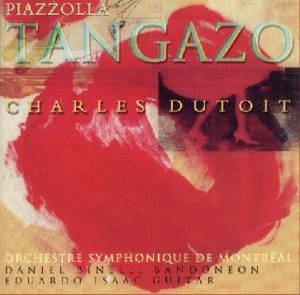Curio Corner
Astor PIAZZOLLA (1921-1992)
Tangazo *Adiòs Nonino *Milonga del ángel, Oblivion Double Concerto for bandoneon and guitar *† Tres movimientos tanguísticos porteños Danza criolla Tangazo
Daniel Binelli (bandoneon) *Eduardo Isaac (guitar) † Louise Pellerin + Orchestre Symphonique de Montreal Conducted by Charles
Dutoit DECCA 468 528-2 [75:47]

Sultry tango music has often been used in films. In fact Piazzolla’s Oblivion included in this compilation is film music. The bandoneon is a square-built button accordion invented in Germany in the 1840s but eventually taken up in Buenos Aires as the chief instrument of the tango bands. Piazzolla’s distinctive brand of tango - "tango nuevo" – is characterised by chromaticism, dissonance, and elements of jazz so his compositions for large ensemble is a fusion of traditional tango jazz and classical music. Dutoit’s Montreal players and his soloists capture the vivid colour and sensuality of these works perfectly. The tango melody of Adós Noninio is probably Piazzolla’s best known work and certainly the most frequently performed. It was written, in 1959, in fond memory of his father who died after complications following a street accident. This orchestral arrangement, dating from 1981, begins unsettlingly and somewhat abrasively with rasping percussion before the mood mellows and becomes affectionate and nostalgic. The Milonga del ángel is a soft sensual slow moving tango, very atmospheric suggesting a sultry moonlight night, with gossamer boudoir curtains billowing gently. Oblivion has the oboe murmuring a plaintive song of yearning against luscious mid-range string harmonies with the bandoneon commenting and picking its way through the texture. Danza criolla breaks the spell: it is wild and abandoned, bouncing along joyfully in resplendent colours. Tangazo, without bandoneon, is intense and densely constructed with a slow and ruminative, almost tragic, opening that gives way to high spirited and humorous material dancing away, the rhythms infectious and the orchestration inventive. This joy alternates with slower passionately romantic tango figures. There are two three-movement works. The Double Concerto for Bandoneon and Guitar adroitly contrasts and blends the two instruments. The Introduction is introspective and slightly melancholy, the Milonga voluptuous and the Tango lively. More impressive and imaginative is the purely orchestral Tres movimentos tanguisticos porteños. It opens on a furtive, almost sinister note then a piano figure announces a seductive challenge with the tango figures passing through a variety of moods: pensive, torrid - even an exotic jungle excursion might be imagined. The Moderato central movement is tenderly nostalgic but moodily seductive too with tempo and rhythm gradually heating. The jungle evocation is recalled, giving way to material that might suggest a sophisticated dinner party with the guests suffering a certain ennui. The Vivace concluding movement is a proud tango employing fugual figures, colourful glissandi, and bouncing rhythms pegged by bold timpani rolls. A work that invites your imagination run riot Hedonistic, exotically coloured tango music in vivid orchestral dress played with conviction and enthusiasm. Just the thing to banish dull winter blues.
Ian Lace

Return to Index